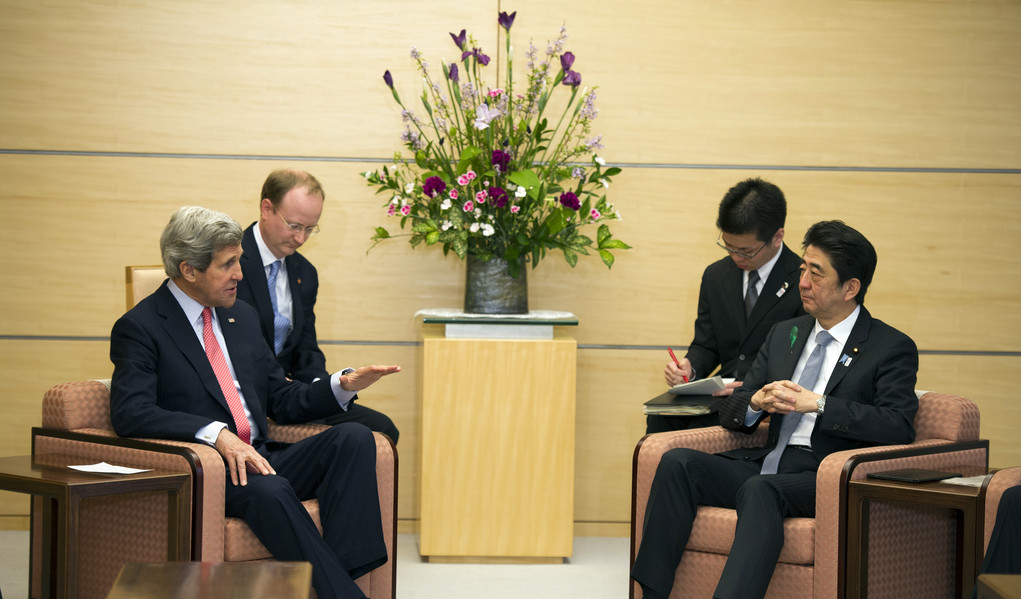Japan’s nationalism, much like their baseball, exists as a constant reminder of the nation’s rapid passage from a feudal society to a Westernized, imperial power. The process that began in the middle of the 19th century — the end of the shogunate, the rise of the ancient Imperial seat, the eventual unification of the state — ultimately found root and grew in the period prior to and including World War II. Then came the U.S. drafted, post-war constitution that is still in place today. Gone was the spiritual power of the emperor, along with the real power of Japan’s military elite. The divine emperor Hirohito famously posed with “Dugout Doug” MacArthur. Japan’s standing army became the country’s “Self-Defense Forces,” an awkward terminology that allowed the Japanese to retain some form of military force despite constitutional provisions forbidding them from maintaining an army or waging war. And, in 1955, current Prime Minister Shinzo Abe’s party, the LDP (Liberal Democratic Party), formed to combat the pacifist constitution thrust upon Japan by the occupied government. The party has consistently and almost continuously held parliamentary power since its formation.
Though his words are not forged in the image of a divine emperor, Abe’s rhetoric harkens back to the good old days. In an entirely symbolic victory, Abe this year created a national holiday entitled “Restoration of Sovereignty Day,” marking the official end of the Allied occupation on April 28th, 1952. “Japan is back” has become something of a catchphrase used to describe Abe’s not-so-unique brand of politicking, though back from what exactly is not particularly clear. It’s with the hope of turning back the clock that Abe and the LDP offer a paradoxically transformative vision for 21st century Japan. Much of this vision concerns a drastic, and at times rhetorically controversial, revision of the constitution. Abe has gained traction in his attempts at constitutional reform, not only from fellow LDP members but also from other reaches of Japanese politics. It’s not hard to see how, though, considering first the nation’s natural inclination to desire a sovereign right to declare war and stand a recognized army, and second the innumerable ways in which global politics have changed since 1947.
Perhaps the strongest area in which Abe’s brand of nationalism has taken hold lies in the economic realm. The prime minister’s ambitious expansionary policy, dubbed “Abenomics” upon its introduction last year, seems to have had no trouble gaining support among the business community. It’s a policy promoted as a way forward for Japan, a means for the nation to, not surprisingly, “bounce back” from the lost decades of economic stagnation. If it is this period to which Abe refers when he talks of Japan being “back,” then we find in Abe’s platform an amalgamation of two different, historical Japans – the first, the economically robust nation that rose from the ashes of two atomic bombs to become the world’s second largest economy by 1990; the second, the singularly dominant physical presence in East and Southeast Asia exhibited by pre-war, Imperial Japan.
This physical presence has come to bear most visibly in the dispute with China over the Senkaku Islands that lie just north of Taiwan. Much has been written on this subject, and always present is the sort of posturing one would expect from a territorial dispute over two rocks in the Pacific. Another issue, more symbolic, has been Abe’s much-maligned visits to the Yasukuni shrine, a war memorial honoring those who died in the service of Imperial Japan. Abe has not been the first prime minister to visit the shrine, nor will he be the last, but it is disquieting considering Abe’s views on the Comfort Women and the Japanese conquest of Asia. Resentment over that brutal period still burns in many Asian nations, China and the Koreas particularly, and one can hardly think that Abe’s words help to heal old wounds.
It’s been interesting to see how Abe’s brand of nationalism has gained traction this time around. When he left office in 2007, mired in a scandal caused by the suicide of one of his own cabinet members, Abe’s ratings hovered below thirty percent. Today, Abe, who enjoys approval ratings around sixty percent, and the LDP fared extremely well in Japan’s elections for the upper house. Abe and the LDP will no doubt point to these results as a vote for the Prime Minister’s nationalist bent, an affirmation of both Abenomics and his campaign for stronger national defense. They may be right. But much of the “success” of Abe’s economic programs have been based on hope, and Abe’s words on the Senkaku Islands, China, and other matters of East Asian politics have been just that thus far. There’s plenty more at play here. Perhaps the Japanese feel like the U.S., seemingly drawn every which way except up, are no longer a reliable ally. For fifty years Japan didn’t have to posture; it had America to do that for them. Now that may no longer be the case. As China looms large to the west, as southeast Asia roars and Myanmar increasingly becomes the greatest economic opportunity in southern Asia in the last decade, Japan is afraid of missing the train. It makes sense that their hopes would come to lie in a conservative nationalist who promises a “new Japan.”
